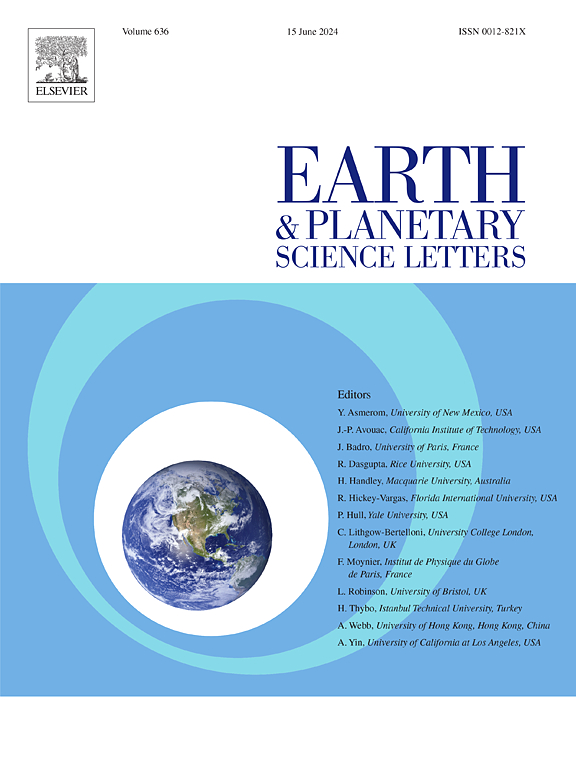显生宙轨道尺度的冰川-上升变率
IF 4.8
1区 地球科学
Q1 GEOCHEMISTRY & GEOPHYSICS
引用次数: 0
摘要
全球平均海平面对大陆边缘的沉积系统、生物地球化学循环和气候有很强的影响。基于同位素地球化学或板块重建的显生宙构造-冰川-上升曲线提供了一级趋势,但不能解决短期(<1 Myr)高振幅冰体积强迫变率,这导致古生代和新生代冰库时期>;100 m的冰川-上升波动。在中生代温室气候中,这些冰川-上升波动很小(~ 20 - 40 m)或不存在。我们提供了最近5.4亿年最大振幅短期海平面变化的连续量化。我们利用一个高分辨率的新生代气候模型来估计轨道尺度(103-105年)温度和冰体积变化作为冰体积长期(≥1 Myr)变化的函数。在最近长期冰体积重建的基础上,我们计算了整个显生宙的最大可行轨道周期。我们对温室气候期间海平面变化的估计远低于一些基于地层学衍生的海平面上升重建的估计。这表明这些地层学方法高估了轨道尺度的海平面变化,或者这些变化是由其他因素引起的,如含水层沉降。我们的分析量化了冰川-上升海平面变率的范围,这可能在未来的古气候学、古地理、古生物学和古海洋学研究中作为独立的约束。本文章由计算机程序翻译,如有差异,请以英文原文为准。

Phanerozoic orbital-scale glacio-eustatic variability
Global Mean Sea Level, or eustasy, has a strong effect on depositional systems, biogeochemical cycles, and climate along continental margins. Long-term Phanerozoic Tectono-Glacio-Eustatic curves based on isotope geochemistry or plate reconstructions provide first-order trends but cannot resolve short-term (<1 Myr) high amplitude ice volume-forced variability, that resulted in glacio-eustatic fluctuations of >100 m during Paleozoic and Cenozoic icehouse times. These glacio-eustatic fluctuations were minor (∼20 – 40 m) to absent during Mesozoic greenhouse climates. We provide a continuous quantification of maximum amplitude short-term sea level change during the last 540 million years. We utilize a high-resolution Cenozoic climate model to estimate orbital-scale (103-105 years) temperature and ice volume variations as a function of long-term (≥ 1 Myr) changes in ice volume. Building upon a recent long-term ice volume reconstruction, we then calculate maximum feasible orbital-scale cyclicity for the entire Phanerozoic. Our estimates of sea level change during greenhouse climates are much lower than some estimates based on stratigraphically derived eustatic reconstructions. This suggests that these stratigraphic methods overestimate orbital-scale sea level change or that these were caused by other factors such as aquifer eustasy. Our analysis quantifies the range of glacio-eustatic sea level variability that may be used as independent constraint in future paleoclimatologic, paleogeographic, paleontologic, and paleoceanographic research.
求助全文
通过发布文献求助,成功后即可免费获取论文全文。
去求助
来源期刊

Earth and Planetary Science Letters
地学-地球化学与地球物理
CiteScore
10.30
自引率
5.70%
发文量
475
审稿时长
2.8 months
期刊介绍:
Earth and Planetary Science Letters (EPSL) is a leading journal for researchers across the entire Earth and planetary sciences community. It publishes concise, exciting, high-impact articles ("Letters") of broad interest. Its focus is on physical and chemical processes, the evolution and general properties of the Earth and planets - from their deep interiors to their atmospheres. EPSL also includes a Frontiers section, featuring invited high-profile synthesis articles by leading experts on timely topics to bring cutting-edge research to the wider community.
 求助内容:
求助内容: 应助结果提醒方式:
应助结果提醒方式:


